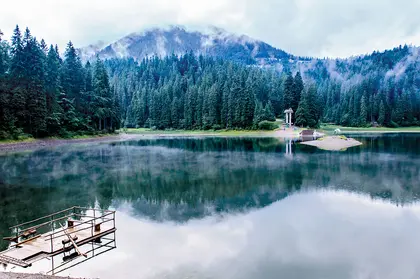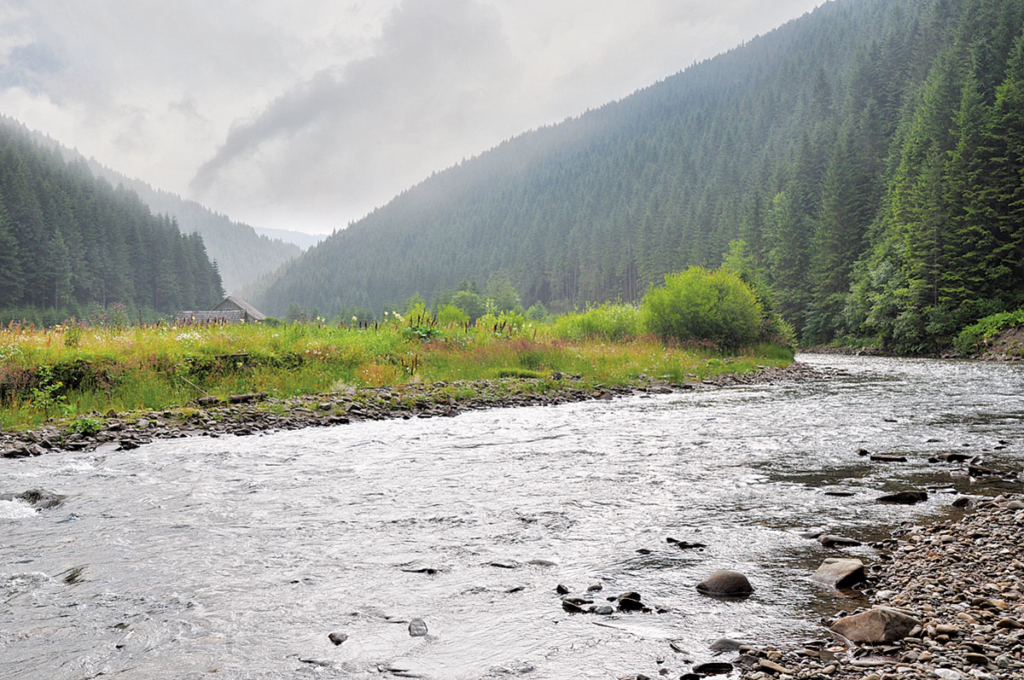When it comes to waterside vacation options, Ukraine has a lot more to offer than just the Black and Azov sea coasts.
The country is dotted with lakes and crisscrossed with rivers, where vacationers can swim, kayak, go rafting, or just sprawl on the sand in the summer heat.
JOIN US ON TELEGRAM
Follow our coverage of the war on the @Kyivpost_official.
Among the best vacation spots are the beautiful Lake Synevyr and the salty Lake Kunihunda in Zakarpattya Oblast, the azure Blue Lakes of Chernihiv Oblast, the whitish Bile Lake in Rivne Oblast, and the winding Black Cheremosh River in Ivano-Frankivsk Oblast.
Lake Synevyr
Lake Synevyr, located in the natural park of the same name in western Zakarpattya Oblast, is the biggest and the deepest lake of the Ukrainian Carpathians.
It’s also one of the most popular tourist destinations in the region, with tens of thousands people coming there every year, says Tanya Smirnova, an author at the IGotoWorld.com travel website.
According to local legends, the lake takes its name from a love story with a sad ending: Synevyr is allegedly a compound of the names Syn and Vyr. The legends say that Syn was the young daughter of a count, named for her beautiful blue eyes (from “syny” meaning blue). Vyr was a poor shepherd. When the two met, they fell in love at once.
But Syn’s rich father, incensed at the prospect of such a union, had Vyr killed by having boulders thrown on him.
When Syn found his body, her blue eyes wept so many tears that a lake formed, and the boulders became the small island in the middle of the lake. A 13-meter-high wooden monument dedicated to the legendry lovers has been built on the side of the lake.
Seen from above, with its islet in the middle, Synevyr looks like an eye, so the lake is also called the Sea Eye of the Carpathians.
Swimming and fishing in Lake Synevyr are prohibited, but there is a special wooden raft visitors can use to sail to the islet or across the lake. The average depth of the lake is about 10–12 meters.
A cafe, souvenir shops, and a rope park are nearby, as well as accommodation options.
To get there by car from Ivano-Frankivsk, take the H10 to Dolyna, then turn south onto the P‑21. Once in Mizhhirya, take the T0720 to the Synevyr National Park, and then take the T0724 and follow the signs to Lake Synevyr.
Entrance to the lake area costs Hr 21.
Rooms cost Hr 75–300 per night to rent.
Lake Kunihunda
Solotvyno, a western Ukrainian village close to the border with Romania, is famous for its salty lakes, and Lake Kunihunda is the biggest of them.
According to travel agency AvesTravel, the lake formed in 1902 at the site of an old salt mine, and is named after the wife of Yaropolk, the ruler of Kyiv in the late 10th century. Apparently, Kunihunda loved to visit this beautiful corner of Ukraine.
The shores of the lake, whose salty waters are believed to have beneficial effects for health, are lined with resorts and hotels providing salt baths and mud wraps, along with other therapeutical procedures.
To get there, travel to Uzhgorod or Ivano-Frankivsk, then drive southeast to the town of Tiachiv, and from there further southeast to Solotvyno.
The price of a room in the town starts at Hr 200 per night.
Blue Lakes
Blue Lakes is a four-lake complex nestled in the beautiful forests of Chernihiv Oblast, close to the border with Belarus.
The lakes there are indeed blue, due to the properties of the quartz sands at their bottoms that tint the waters.
Natalia Grebovich, one of the authors of the Travels Ukraine tourism website, says that the biggest one — the 25-hectare Velyke Lake, or Big Lake, is 20 meters deep and is the most popular with tourists. The Blue Lakes hotel complex, which has two beach areas, restaurants, a sauna, a shooting range, sports grounds for kids and adults and bicycle rental service, stands near the shores of Velyke Lake.
The lakes are worth a visit in winter, too, offering ice fishing, cross-country skiing, skating and more.
Get there by train to Hrybova Rudnya station, and then walk less than a kilometer to the lakes.
An economy suite costs Hr 300 per day, a standard room costs Hr 950 per day.
Bile Lake
While blue is the usual color for a lake, there are several Bile Lakes, or White Lakes in Ukraine. One of the best known of them, located in Rivne Oblast near the village of Rudka, has a whitish hue for two reasons.
According to AvesTravel, the first reason is area’s characteristic karst topography – porous limestone bedrock which gives the lake water a chalky tint. The second reason is the reflection on the water of the frequent fogs that hang over the surface of the lake.
Despite its pale appearance, the water is clear and transparent for two of its 10 meters of depth. So it’s easy to spot a fish, beaver or muskrat.
Tourists can also find some rare plants nearby such as Merlin’s Grass, which is listed in the Red Book of Ukraine of rare and endangered species.
Bile Lake is the only Ukrainian lake with potable-quality water that has a high content of glycerol, said to give it healing properties.
The lake’s beaches are sandy and clean, and the surrounding forests are rich with berries and mushrooms. Tourists can also rent a catamaran, a boat or a jet ski.
To get there, go to the town of Varash (formerly Kuznetsovsk) on a shuttle bus from Rivne or Lutsk. From there, take a taxi to the village of Rudka village.
Prices for a room start from Hr 200 per night.
Black Cheremosh River
If relaxing on a lakeside beach seems too sedate, try rafting on the wild Black Cheremosh River. This 87-kilometer river starts in the Carpathians and offers an exciting ride of sudden turns, rapids, gorges, and whirlpools.
Oksana Arkhypychuk of the Active Ukraine travel agency says that the most thrilling 10-kilometer stretch of the river for rafting and kayaking lies between the villages of Dzembronya and Krasnyk.
Only skillful rafters and kayakers can tackle this part of the river by themselves however, so beginners should hire an instructor for supervision.
International events, national competitions and tours are held on the river. The best times for kayaking and rafting are spring, when melted snow fills rivers with lots of water, and summer after periods of heavy rain and storms.
There is a campsite in Dzembronya, next to the river. Visitors can also choose to rent a room or a cottage.
To get there, take a train to Ivano-Frankivsk then a bus to the village of Verkhovyna, and then take a bus to the village of Dzembronya.
Renting a room will cost around Hr 400 per day.
You can also highlight the text and press Ctrl + Enter





